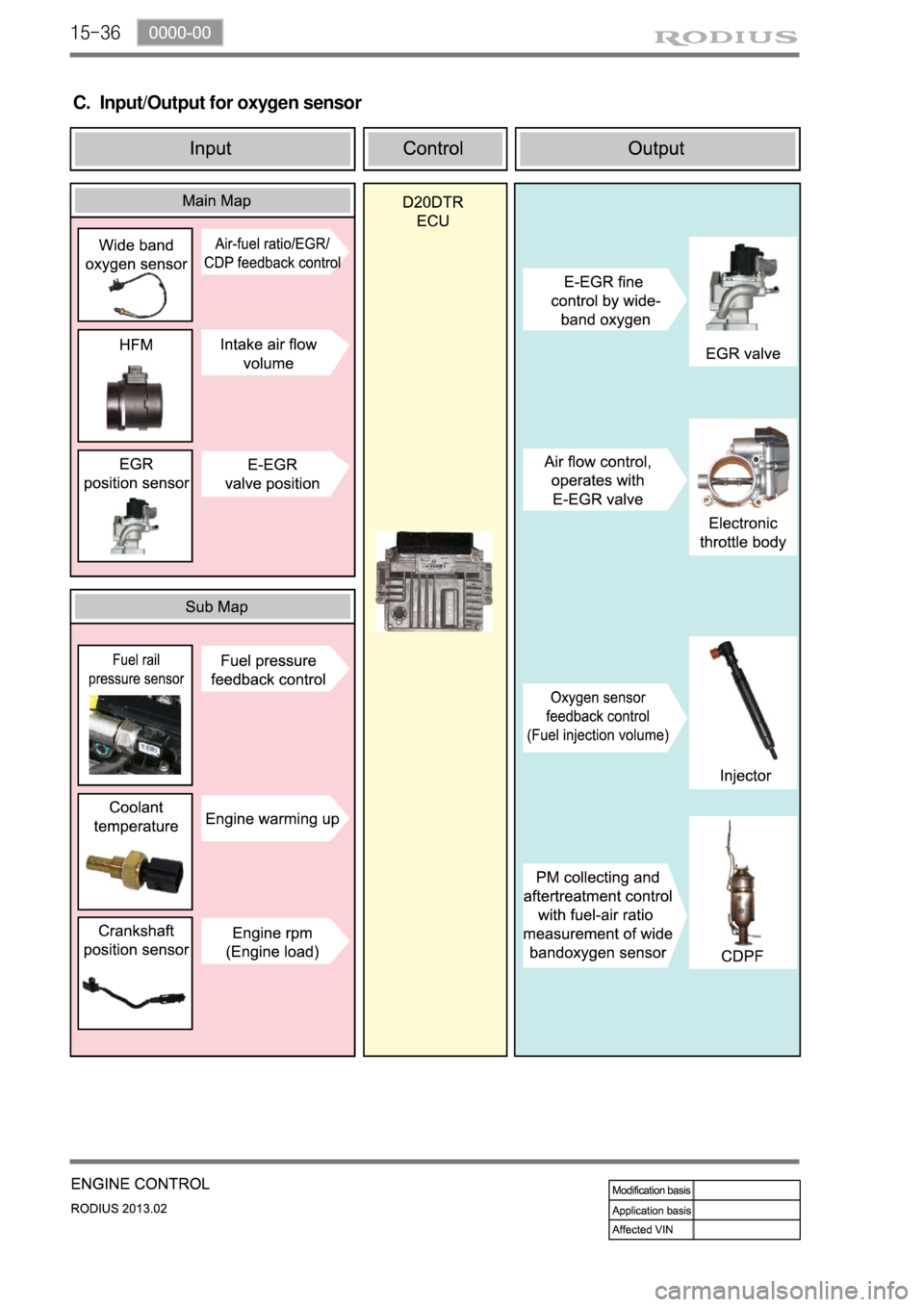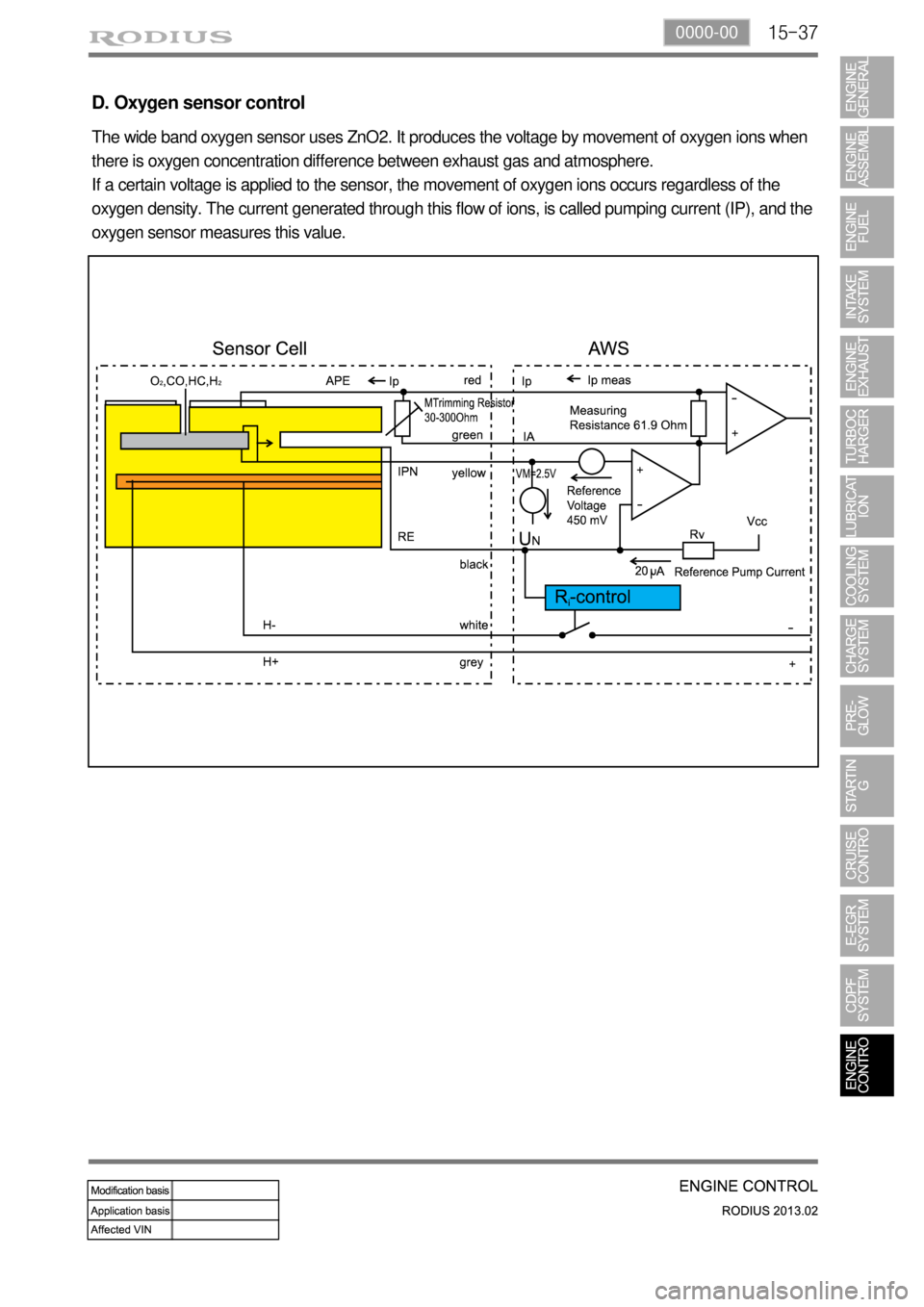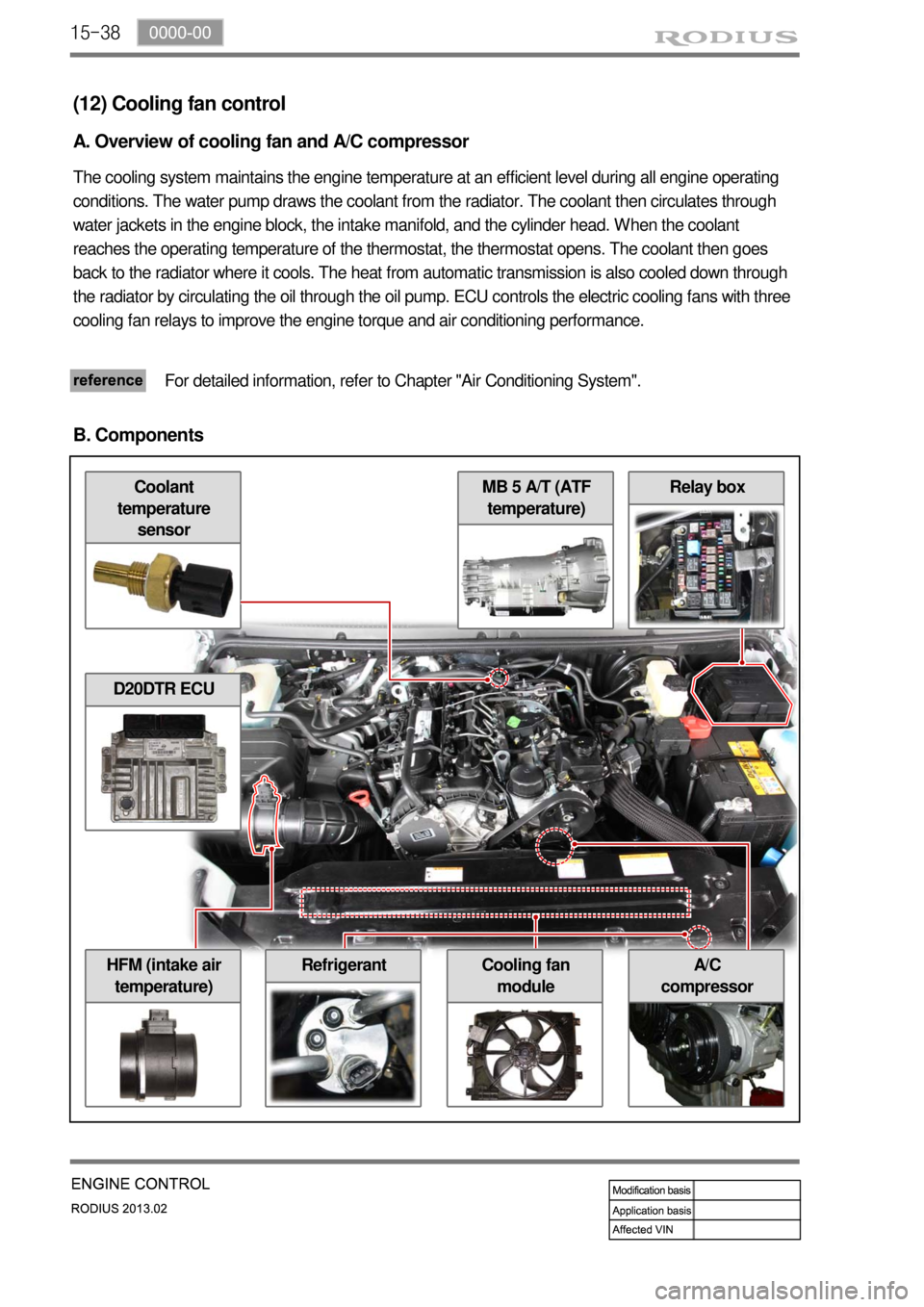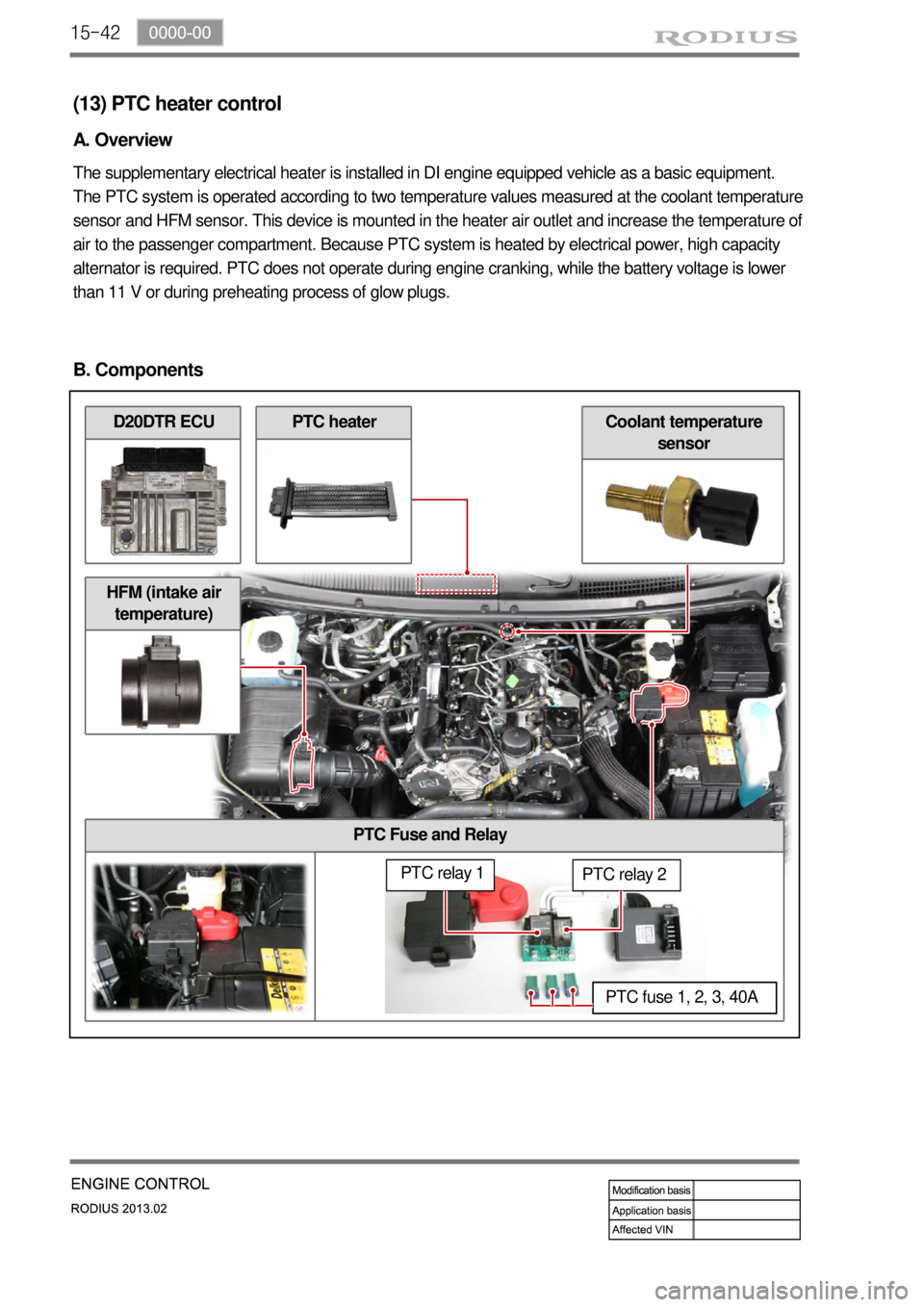sensor SSANGYONG TURISMO 2013 Workshop Manual
[x] Cancel search | Manufacturer: SSANGYONG, Model Year: 2013, Model line: TURISMO, Model: SSANGYONG TURISMO 2013Pages: 796, PDF Size: 78.99 MB
Page 356 of 796

15-28
Electric throttle
bodyAccelerator
pedal
moduleD20DTR
ECU
(9) EGR control
A. Overview
The EGR (Electric-Exhaust Gas Recirculation) valve reduces the NOx emission level by recirculating
some of the exhaust gas to the intake system.
To meet Euro-V regulation, the capacity and response rate of E-EGR valve in D20DTR engine have
been greatly improved. The EGR cooler with high capacity reduces the Nox, and the bypass valve
reduces the CO and HC due to EGR gas before warming up.
Also, the engine ECU adjusts the E-EGR opening by using the air mass signal through HFM sensor. If
the exhaust gas gets into the intake manifold when the EGR valve is open, the amount of fresh air
through HFM sensor should be decresed.
B. Components
E-EGR cooler
Coolant
temperature
sensorOxygen sensor
HFM (intake
air
temperature)
Crankshaft
position
sensorE-EGR valve
T-MAP
sensor
Page 358 of 796

15-30
D. Bypass control for EGR cooler
Cooler temperature ▶
When the coolant temperature is below 70℃, the exhaust gas is bypassed the EGR cooler.
Exhaust gas temperature ▶
When the exhaust gas tem
perature is below 300℃, the exhaust gas is bypassed the EGR cooler
Otherwise, PM could be increased due to too low exhaust gas temperature.
E. Control elements for EGR system
Accelerator pedal (engine load) - Indicates the driver's intention and engine load. If the load goes
up, the EGR ratio is decreased.
T-MAP (boost pressure map stored in ECU) - Compensates the difference in boost pressure by
adjusting EGR ratio.
Engine rpm - Used as the signal for determining EGR operating range.
Coolant temperature - When the coolant temperature is low, NOx is decreased but PM could be
increased. So, to reduce PM, decrease EGR ratio when the coolant temperature is low.
Intake air mass and temperature - HFM sensor measures the intake air mass to calculate the
actual EGR volume. If the air mass is larger than programmed value in map, EGR ratio will be
higher.
EGR position sensor - Detects the actual opening angle of EGR valve and performs feedback
function according to PWM control by ECU.
Wide band oxygen sensor - Detects the oxygen volume in exhaust gas to check if the EGR ratio is
proper.
Electronic throttle body - Keeps EGR ratio to optimized level by controlling the throttle body in EGR
operating range (decreasing pressure in intake manifold). -
-
-
-
-
-
-
-
Page 360 of 796

15-32
(10) E-VGT control
A. Overview
E-VGT (Electric-Variable Geometry Turbine) turbocharger system in D20DTR engine uses the venturi
effect that controls the flow rate of exhaust gas by adjusting the passage in turbine housing. The newly
adopted DC motor actuator (E-actuator) controls the E-VGT system more precisely and faster. To get
the high operating power from turbine, the ECU reduces the exhaust gas passage In low speed range
and increases it in high speed range.
B. Components
HFM (intake air
temperature)
Front EGT
sensor
E-VGT actuatorAccelerator pedal
module
Crankshaft
position
sensorOxygen sensor
T-MAP sensor
Coolant
temperature
sensor
D20DTR ECU
Page 363 of 796

15-350000-00
HFM (intake air
temperature)CDPF
Electric throttle
bodyCoolant
temperature
sensorOxygen sensor
Injector (C3I)
E-EGR valve
(11) Wide band oxygen sensor control
A. Overview
For diesel engine, combustion is not performed at the optimum (theoretically correct) air-fuel ratio and
the oxygen concentration is thin in most cases. So the wide-band oxygen sensor is used for this kind o
f
engine, and this sensor is a little different from the one that used for gasoline engine. The combustion
in diesel engine is controlled by fuel injection volume. Therefore, the wide band oxygen sensor should
be used in diesel engine. This sensor measures the air-fuel ratio in very wide range, and is also called
full range oxygen sensor.
The wide band oxygen sensor measures the oxygen density in exhaust gas and sends it to ECU
to control the EGR more precisely. -
B. Components
D20DTR ECU
Page 364 of 796

15-36
C. Input/Output for oxygen sensor
Page 365 of 796

15-370000-00
D. Oxygen sensor control
The wide band oxygen sensor uses ZnO2. It produces the voltage by movement of oxygen ions when
there is oxygen concentration difference between exhaust gas and atmosphere.
If a certain voltage is applied to the sensor, the movement of oxygen ions occurs regardless of the
oxygen density. The current generated through this flow of ions, is called pumping current (IP), and the
oxygen sensor measures this value.
Page 366 of 796

15-38
Relay box
A/C
compressorHFM (intake air
temperature)Cooling fan
module
MB 5 A/T (ATF
temperature)Coolant
temperature
sensor
(12) Cooling fan control
A. Overview of cooling fan and A/C compressor
The cooling system maintains the engine temperature at an efficient level during all engine operating
conditions. The water pump draws the coolant from the radiator. The coolant then circulates through
water jackets in the engine block, the intake manifold, and the cylinder head. When the coolant
reaches the operating temperature of the thermostat, the thermostat opens. The coolant then goes
back to the radiator where it cools. The heat from automatic transmission is also cooled down through
the radiator by circulating the oil through the oil pump. ECU controls the electric cooling fans with three
cooling fan relays to improve the engine torque and air conditioning performance.
For detailed information, refer to Chapter "Air Conditioning System".
B. Components
D20DTR ECU
Refrigerant
Page 369 of 796

15-410000-00
A/C compressor OFF conditions ▶
Coolant tem
perature: below -20℃ or over
115℃
Engine rpm: over 4500 rpm
Engine rpm: below 600 rpm
When abrupt acceleration
Very high load during idling
Refrigerant pressure: over 32 bar or below 2
bar
Failure in refrigerant sensor, coolant
temperature sensor, and cooling fan -
-
-
-
-
-
-
Page 370 of 796

15-42
PTC Fuse and Relay
(13) PTC heater control
A. Overview
The supplementary electrical heater is installed in DI engine equipped vehicle as a basic equipment.
The PTC system is operated according to two temperature values measured at the coolant temperature
sensor and HFM sensor. This device is mounted in the heater air outlet and increase the temperature of
air to the passenger compartment. Because PTC system is heated by electrical power, high capacity
alternator is required. PTC does not operate during engine cranking, while the battery voltage is lower
than 11 V or during preheating process of glow plugs.
B. Components
HFM (intake air
temperature)
Coolant temperature
sensor
PTC relay 1
D20DTR ECU
PTC relay 2
PTC fuse 1, 2, 3, 40A
PTC heater
Page 371 of 796

15-430000-00
C. PTC operation process
The PTC operating condition (ON) is controlled in two steps.
Basically, the engine ECU controls the relay to supply the power to PTC according to the coolant
temperature sensor and ambient temperature sensor.
1st step (initial operation of PTC) ▶
Coolant temperature < 15°C: PTC ON
Coolant temperature ≥ 15°C: PTC ON after satisfying the conditions in 2nd step -
-
2nd step (coolant temperature ≥ 15°C) ▶
Coolant temperature ≤ 65°C and intake air temperature ≤ -10°C: PTC ON
Coolant temperature < 60~65°C and intake air temperature < -10~0°C: PTC ON
Coolant temperature ≤ 60°C and intake air temperature ≤ 0~5°C: PTC ON -
-
-
Stop (OFF) conditions ▶
A/C blower switch OFF
Defective ambient air temperature sensor (including open or short circuit)
Engine cranking
Low battery voltage (below 11V)
During pre-glow process (glow indicator ON) -
-
-
-
-